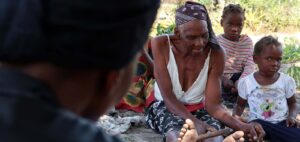[This text has been written by por Matiana González Silva and Regina Rabinovich, coordinator and director, respectively, of the Malaria Elimination Initiative].
World Malaria Day 2021 – While no definitive data are yet available, we know that the pandemic has not interrupted malaria prevention programmes and there is good news from China and El Salvador.
The announcement by the World Health Organisation (WHO) in early 2020 that the COVID-19 outbreak had become a pandemic sent a shiver of fear through the whole malaria community. The most pessimistic projections estimated that deaths from malaria could double if health systems became saturated and could no longer treat malaria patients or deliver preventive measures. One year on, we do not yet have data on what the actual impact has been, but we do know, at least, that in most African countries the pandemic did not interrupt the distribution of mosquito nets or disrupt the distribution channels for diagnostics and medicines. And furthermore, 2021 has brought us some good news, something exceptional in these times: in February, El Salvador—one of the smallest countries in the world—was certified by the WHO as malaria-free and China—one of the largest—is expected to receive the same certification this summer.
The announcement by the WHO in early 2020 that the COVID-19 outbreak had become a pandemic sent a shiver of fear through the whole malaria community
Besieged as we are with health problems and given the focus of attention on COVID-19, these advances are not insignificant. They show us that the oft repeated message that malaria can be prevented, cured and even eliminated is more than just a collection of words: it is a palpable reality. In 2019, 24 countries reporting under 10 cases a year were making steady progress towards the goal of eliminating malaria from their territories, following in the footsteps of many others which have achieved this goal in the past, including most European countries.
How Was That Goal Achieved?
Malaria is a disease with a diverse range of epidemiological characteristics involving a variety of species of mosquitoes and malaria parasites as well as differences in health systems, climate, economic development and many other factors. Nevertheless, a review of past history reveals a number of common elements shared by the countries that have achieved elimination to date. These include the application of strategies adapted to the specific conditions of the area, the presence of a robust and free health care system, coordination between all the relevant actors, the ability to maintain commitment, and sufficient funding.
To this we must also add all the scientific research that has made progress against malaria possible, starting at the end of the 19th century, when scientists first identified the parasite that causes the disease and the mosquito’s role as its vector. Along the way, many tools have been developed and many more, such as chloroquine and DDT, have been abandoned following the development of resistance.
Most of the tools and interventions used today in countries where the disease is endemic were developed in the 1990s. They include indoor residual spraying to kill mosquitoes, insecticide-treated bed nets to protect against mosquito bites, rapid diagnostic testing even in remote villages, a fairly wide range of drugs, and intermittent antimalarial treatments to prevent infection in the most vulnerable populations (babies, children and pregnant women).
Improved coordination between the different actors and the increasing availability of funds and scientific and technological developments led to spectacular advances in the first 15 years of this century. But, progress has been stalled for about the last three years
After the horrific epidemics of the 1970s and 1980s, improved coordination between the different actors and the increasing availability of funds and scientific and technological developments led to spectacular advances in the first 15 years of this century. However, the efficacy of all of the tools currently available is only partial and in some cases diminishing due to the emergence of resistance to insecticides, drugs and even diagnostic tests. Moreover, we have no tools against the residual transmission that occurs when people are not protected in their homes or sleeping under a bed net. As a result, progress has been stalled for about the last three years.
The international community has high hopes for a new tool that may be available by the end of this year: the RTS,S vaccine. Following completion of the traditional efficacy trials, three pilot projects with this vaccine have been implemented in recent years in Africa to assess the effectiveness of the vaccine in real-world conditions. The results of these pilot studies will be analysed this summer and it is expected that in autumn 2021 the WHO will decide whether or not to recommend widespread use of the vaccine.
The international community has high hopes for a new tool that may be available by the end of this year: the RTS,S vaccine
However, the RTS,S vaccine is also only partially effective, meaning that all the other efforts must continue without pause. The good news is that COVID-19 has shown us that, with a clear objective and abundant resources, science can advance at a spectacular pace. Let us hope that we can learn this important lesson and that the international community will work together to develop a new generation of malaria interventions that will enable us to move towards the elimination of this ancient and deadly disease.

World Malaria Day






